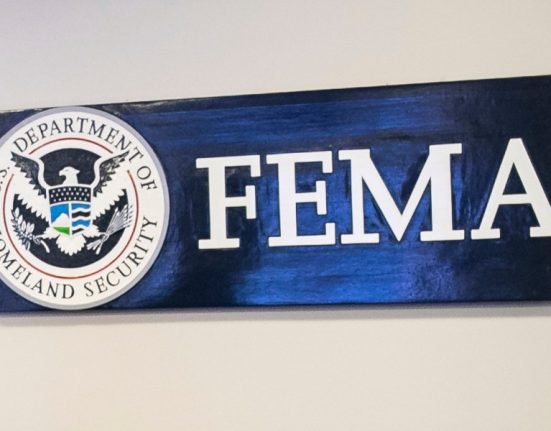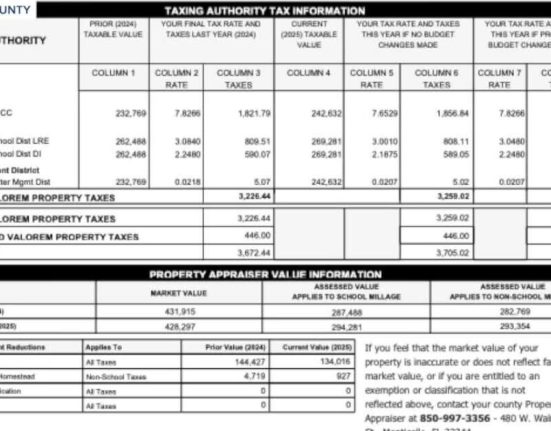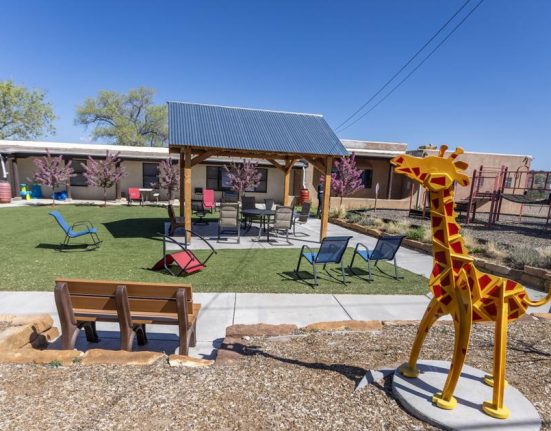Sign up for TPR Today, Texas Public Radio’s newsletter that brings our top stories to your inbox each morning.
San Antonio City Manager Erik Walsh presented a $4.04 billion proposed city budget to the San Antonio City Council on Thursday.
The operating budget, which is how the city pays for most resident services and departments like the San Antonio Police Department and the Parks Department and is also known as the general fund, has a proposed total of $1.69 billion.
The city had to close a $21 million gap in projected revenues and expenses and did so by eliminating some civilian roles, cutting department costs, and increasing some permitting fees, without any increase to the city’s tax rate for the 33rd consecutive year.
Walsh said those cuts would have no “major impact” on city services.
Walsh also presented his plan to balance the budget in 2027, when the city will face a $150 million deficit if it does nothing. The councilmembers will only approve the 2026 budget when they vote on Sept. 18.
Overall revenue is expected to remain flat at less than 1% growth, a major constraint on the city budget.
A break-up of the city’s Public Works Department, new fees, and $33.6 million in reduced spending are some of the biggest potential changes coming to the city budget next year.
Department overhauls
The city is also proposing to create a new department, the Homeless Services and Strategy Department, to take on homelessness in San Antonio.
Much of the $30.5 million in direct city funding for homelessness services would be directed through this department, and it would largely come from the Department of Human Services, where homelessness services have operated out of in the past.
San Antonio’s Chief Housing Officer Mark Carmona will lead the department.
But one of the biggest successes highlighted in Close to Home’s report was the reduction of unsheltered veterans by 18% compared to 2023 and a 42% decrease in veterans experiencing chronic homelessness.
The new department would also provide $4.8 million to continue funding the city’s low-barrier shelter hotel, which was previously funded by the pandemic-era American Rescue Plan Act. But Walsh said using the hotel was unsustainable long-term and that the city would need to develop a new plan if it wanted to continue offering low-barrier shelter services after 2026.
The department would increase the number of homeless encampment abatements, when the city clears out homeless encampments and offers services, in recurring locations.
District 2 Interim City Councilmember Leo Castillo-Anguiano said he believes the city needs to reset its direction on the abatements, calling them “a waste of city money.”
“I don’t think that encampment sweeps are helpful, and I think that they only cause more harm in our communities,” Castillo-Anguiano said. “This is the community that I work with at THRIVE. I see it firsthand that forced displacement and property seizure can just strip people of their essential necessities like tents and sleeping bags, hygiene products, medication, and important documents like IDs or birth certificates.”
Other council members like District 7 Councilmember Marina Alderete Gavito said these abatements were necessary for community safety, including for unhoused people.
“We’ve seen a couple of deaths of our unsheltered residents in a drainage ditch,” she said.
The city is also proposing to break up the Public Works Department by creating the Capital Delivery Department (CDD), a move Walsh said will make the city complete projects “better” and “faster.”
The sole focus of the new department would be on delivering bond and capital projects on time, Walsh said, and improving communication with the community and city council offices.
“These individuals will wake up in the morning and go to bed focused on this effort,” he said.
Development Services Department (DSD) Director Mike Shannon will be appointed to lead the new department, effective immediately, and 188 staffers from the Public Works Department will transition into the CDD in October. Amin Tohmaz will be deputy director.
The Public Works Department’s primary focus will become maintaining city infrastructure, including streets, sidewalks, drainage, and traffic systems. Executive Director Razi Hosseini will retire in September, and a search for his replacement is underway.
Fee increases
The proposed budget includes increases in alarm permits and renewal fees; traffic and parking fines, food establishment and air pollution permits; Animal Care Services, Code Enforcement, and City Clerk fees; and San Antonio Fire Department’s EMS and prevention fees.
The city’s goal is to generate $4.5 million in new revenue from the increases to these fees and fines over the next year, and another $7.5 million in 2027.
Walsh said some of these fees had not been increased in more than a decade.
The city is not proposing increases to trash and recycling collection fees, which were raised last year.
Public safety
The San Antonio Police Department and San Antonio Fire Department budgets, collectively, would make up more than 63% of the city’s general fund for 2026, an increase of 2% compared to the current year.
SAPD’s proposed 2026 budget is $630.6 million; that cost is up nearly $27 million from last year.
About $16 million of that cost comes from a 4% compensation increase for officers per the San Antonio Police Officers’ Association’s collective bargaining agreement with the city.
Courtesy of
/
City of San Antonio
Also, the budget recommends the addition of 53 new officers, including 25 new proactive patrol officers not mentioned in budget discussions earlier this summer. The other 28 will work in the new South Flores Substation.
Walsh said adding the 25 proactive patrol officers, which will cost $1.4 million in their first year, was in line with the city’s goal to add 360 proactive patrol officers in five years. If the current plan is approved, the city will have added 190 new proactive officers by the end of 2026, the third of those five years.
The North Side council members Marc Whyte and Misty Spears called for more of these officers to be added during budget conversations earlier in the summer, and on Thursday said Walsh’s additions weren’t enough, alongside Alderete Gavito.
“I’m just going to say it, I want the 100 officers still,” Spears said. “To me, 65 is the floor.”
It would cost the city an extra $2.1 million to hire 65 officers instead of 25, just in the first year. Hiring 100, as Spears requested, would cost a total estimated $5.6 million in the first year.
SAPD will grow even further through the conversion of 65 vacant Parks Police and Airport Police roles into SAPD positions, and 270 academy graduates from six academy classes next year, the first time San Antonio has held that many.
District 4 Councilmember Edward Mungia, whose comments were later echoed by several others, said he thinks the newly elected council should take a look at the city’s plan to add 360 patrol officers and consider whether it still made sense.
“There are six new people sitting up here who haven’t had the benefit to see that plan, or the details of that or what’s been done since that’s been enacted,” he said
The San Antonio Fire Department’s proposed 2026 budget is $428.8 million, $28 million more than this year’s budget.
The primary cause for the jump in funding is an 8% increase in firefighter pay worth $20.8 million. That comes from the San Antonio Professional Firefighters’ Association’s most recent collective bargaining agreement with the city finalized last August.
Also, 12 new firefighters will be added to address medical responses at the busiest fire stations.
The Animal Care Services Department’s (ACS) proposed budget of $33.6 million is up just $1.3 million over last year.
Animal Care Services Director Jonathan Gary said the agency was on track to reach its goal of responding to 100% of critical response calls by early 2026.
Walsh said protecting its funding was a city priority, and that investments in the department over the last several years have been yielding positive results.
“All of our major metrics are moving in the right direction,” he said. “[ACS Executive Director] Jon [Gary] and the team at Animal Care Services are doing an outstanding job.”
ACS is anticipating improving its critical call response rate from 83% this year — already a 20% jump from 2024 — to 97% by the end of 2026. Critical calls are those related to public safety issues like dog bites.
The live release rate is projected to remain nearly the same as the previous two years at 85%, and spay and neuter surgeries are expected to reach 41,459. In 2024, 33,364 sterilization surgeries were performed.
ACS is also anticipating increasing its number of pet adoptions by 1,000 to 6,500 next year.
Infrastructure investment
The proposed budget includes $122 million for nearly 1,500 street projects across 416 miles. It also includes $17 million for 21 miles of new sidewalks and 11 miles of repaired sidewalks.
The city is planning to revamp the Street Maintenance Program, the system the city uses to determine when to repair which streets.
The city’s proposed capital budget also includes $11.4 million for improvements along Beitel Creek, the site of a deadly June flood that left 13 dead.
At least six inches of rain fell in a three-hour period on Thursday, leading to more than a dozen vehicles being washed into a creek. A candlelight vigil was scheduled for Wednesday evening for the victims by the nonprofit San Antonio Aware and Prepared.
Affordable housing
Walsh said the city will be nearly halfway to its goal to build or preserve 28,094 affordable housing units by 2028 as described in the city Strategic Housing Implementation Plan (SHIP) by the end of next year.
There will be $5.67 million for rental assistance and $14.7 million for home repairs, both down compared to last year’s budget.
Walsh said he was also expecting further council discussion on proposing a new housing bond to voters in November. Nearly all of the 2021 housing bond’s $150 million has been allocated to city projects, and the remaining roughly $20 million are anticipated to be used for city land purchases for future projects.
Federal cuts
The city is expecting to receive $162.7 million in federal grants supporting various departments and programs.
The city lost $1.4 million in Metro Health vaccination grants earlier this year that it will not get next year, and last week the Environmental Protection Agency announced it was cutting the federal Solar-for-All program, a loss of $27.1 million to San Antonio’s solar grant.
Walsh said his top concern as it relates to future federal funding are potential cuts to the Community Development Block Grant and HOME Investment Partnership Program, two multibillion-dollar grant programs that offer tens of millions of dollars to cities like San Antonio to support infrastructure, parks programming, affordable housing, and more.
The White House has proposed eliminating two major federal grant programs which provide tens of millions of dollars every year to San Antonio the city uses to support affordable housing.
The White House has proposed eliminating both, and the relevant congressional subcommittees have proposed $100 million cuts to CDBG and a conflicted position on HOME between full funding and elimination.
Walsh said the city would organize tabletop exercises across city departments to better understand what cuts to programs like those could mean for city services.
Employee pay
The city proposed reducing anticipated cost of living adjustment raises to city civilian employees from 3% to 2%, which Walsh said would produce a savings of $6 million in 2026.
Combined with SAFD and SAPD pay, that would result in $50 million in city employee compensation in 2026.
But the city council nearly unanimously pushed back on cuts to civilian employees’ wage increase and advocated to return it to 3%, especially with a proposed increase to employees’ healthcare premiums.
“When we consider the premium increases, if you have a family, it essentially nullifies that 2% cost of living adjustment,” District 5 Councilmember Teri Castillo said.
Courtesy of
/
City of San Antonio
Next steps
The city will begin holding citywide budget town halls in each of the 10 council districts on Monday. The city council will begin having department-by-department budget work sessions beginning on Tuesday to get even more detailed budget information and offer their feedback.
The council will vote to adopt the 2026 budget on Sept.18.







